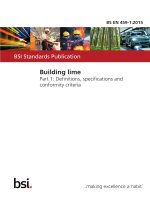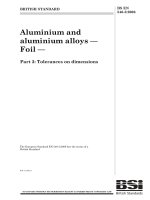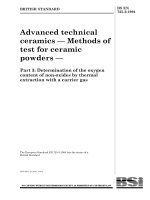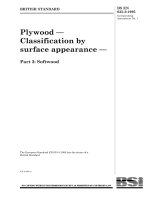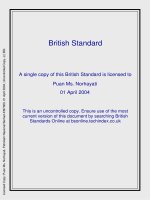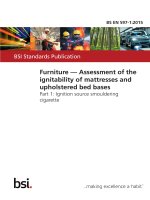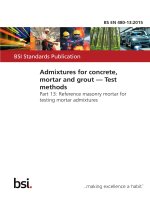Bsi bs en 62150 3 2015
Bạn đang xem bản rút gọn của tài liệu. Xem và tải ngay bản đầy đủ của tài liệu tại đây (1.44 MB, 28 trang )
BS EN 62150-3:2015
BSI Standards Publication
Fibre optic active components
and devices — Test and
measurement procedures
Part 3: Optical power variation induced by
mechanical disturbance in optical receptacles
and transceiver interfaces
BRITISH STANDARD
BS EN 62150-3:2015
National foreword
This British Standard is the UK implementation of EN 62150-3:2015. It is
identical to IEC 62150-3:2015. It supersedes BS EN 62150-3:2012 which is
withdrawn.
The UK participation in its preparation was entrusted by Technical
Committee GEL/86, Fibre optics, to Subcommittee GEL/86/3, Fibre optic
systems and active devices.
A list of organizations represented on this committee can be obtained on
request to its secretary.
This publication does not purport to include all the necessary provisions of
a contract. Users are responsible for its correct application.
© The British Standards Institution 2015.
Published by BSI Standards Limited 2015
ISBN 978 0 580 83712 8
ICS 33.180.20
Compliance with a British Standard cannot confer immunity from
legal obligations.
This British Standard was published under the authority of the
Standards Policy and Strategy Committee on 30 September 2015.
Amendments/corrigenda issued since publication
Date
Text affected
BS EN 62150-3:2015
EUROPEAN STANDARD
EN 62150-3
NORME EUROPÉENNE
EUROPÄISCHE NORM
August 2015
ICS 33.180.20
Supersedes EN 62150-3:2012
English Version
Fibre optic active components and devices Test and measurement procedures Part 3: Optical power variation induced by mechanical
disturbance in optical receptacles and transceiver interfaces
(IEC 62150-3:2015)
Composants et dispositifs actifs à fibres optiques Procédures fondamentales d'essais et de mesures Partie 3: Variation de puissance optique induite par des
perturbations mécaniques dans les interfaces d'embases et
d'émetteurs-récepteurs optiques
(IEC 62150-3:2015)
Aktive Lichtwellenleiter-Bauteile und -Bauelemente Grundlegende Prüf- und Messverfahren Teil 3: Optische Leistungsabweichungen bedingt durch
mechanische Störungen in optischen Kupplungen und
Transceiver-Schnittstellen
(IEC 62150-3:2015)
This European Standard was approved by CENELEC on 2015-06-11. CENELEC members are bound to comply with the CEN/CENELEC
Internal Regulations which stipulate the conditions for giving this European Standard the status of a national standard without any alteration.
Up-to-date lists and bibliographical references concerning such national standards may be obtained on application to the CEN-CENELEC
Management Centre or to any CENELEC member.
This European Standard exists in three official versions (English, French, German). A version in any other language made by translation
under the responsibility of a CENELEC member into its own language and notified to the CEN-CENELEC Management Centre has the
same status as the official versions.
CENELEC members are the national electrotechnical committees of Austria, Belgium, Bulgaria, Croatia, Cyprus, the Czech Republic,
Denmark, Estonia, Finland, Former Yugoslav Republic of Macedonia, France, Germany, Greece, Hungary, Iceland, Ireland, Italy, Latvia,
Lithuania, Luxembourg, Malta, the Netherlands, Norway, Poland, Portugal, Romania, Slovakia, Slovenia, Spain, Sweden, Switzerland,
Turkey and the United Kingdom.
European Committee for Electrotechnical Standardization
Comité Européen de Normalisation Electrotechnique
Europäisches Komitee für Elektrotechnische Normung
CEN-CENELEC Management Centre: Avenue Marnix 17, B-1000 Brussels
© 2015 CENELEC All rights of exploitation in any form and by any means reserved worldwide for CENELEC Members.
Ref. No. EN 62150-3:2015 E
BS EN 62150-3:2015
EN 62150-3:2015
European foreword
The text of document 86C/1311/FDIS, future edition 2 of IEC 62150-3, prepared by SC 86C "Fibre
optic systems and active devices" of IEC/TC 86 "Fibre optics" was submitted to the IEC-CENELEC
parallel vote and approved by CENELEC as EN 62150-3:2015.
The following dates are fixed:
•
latest date by which the document has to be
implemented at national level by
publication of an identical national
standard or by endorsement
(dop)
2016-03-11
•
latest date by which the national
standards conflicting with the
document have to be withdrawn
(dow)
2018-06-11
This document supersedes EN 62150-3:2012.
EN 62150-3:2015 includes
EN 62150-3:2012:
the
following
significant
technical
changes
with
respect
to
– extension of application field to SC connector interface transceivers in addition to LC connector
interface transceivers specified in the first edition as both transceiver interfaces are very important
in the industry;
– addition of a new Annex E dealing with load value difference for connector type in Method A.
Attention is drawn to the possibility that some of the elements of this document may be the subject of
patent rights. CENELEC [and/or CEN] shall not be held responsible for identifying any or all such
patent rights.
Endorsement notice
The text of the International Standard IEC 62150-3:2015 was approved by CENELEC as a European
Standard without any modification.
In the official version, for Bibliography, the following notes have to be added for the standards indicated:
2
IEC 61300 Series
NOTE
Harmonized as EN 61300 Series.
IEC 61754-4
NOTE
Harmonized as EN 61754-4.
IEC 61754-20
NOTE
Harmonized as EN 61754-20.
BS EN 62150-3:2015
EN 62150-3:2015
Annex ZA
(normative)
Normative references to international publications
with their corresponding European publications
The following documents, in whole or in part, are normatively referenced in this document and are
indispensable for its application. For dated references, only the edition cited applies. For undated
references, the latest edition of the referenced document (including any amendments) applies.
NOTE 1 When an International Publication has been modified by common modifications, indicated by (mod), the relevant
EN/HD applies.
NOTE 2 Up-to-date information on the latest versions of the European Standards listed in this annex is available here:
www.cenelec.eu
Publication
Year
Title
EN/HD
Year
IEC 61753
Series
Fibre optic interconnecting devices and
passive components - Performance
standard
EN 61753
Series
IEC 61753-021-6
-
Fibre optic interconnecting devices and
EN 61753-021-6
passive components performance standard
- Part 021-6: Grade B/2 single-mode fibre
optic connectors for category O Uncontrolled environment
-
IEC 61754
Series
Fibre optic interconnecting devices and
passive components - Fibre optic
connector interfaces
Series
EN 61754
3
–2–
BS EN 62150-3:2015
IEC 62150-3:2015 © IEC 2015
CONTENTS
FOREWORD ........................................................................................................................... 4
1
Scope .............................................................................................................................. 6
2
Normative references ...................................................................................................... 6
3
Terms, definitions and abbreviations ............................................................................... 6
3.1
Terms and definitions .............................................................................................. 6
3.2
Abbreviations .......................................................................................................... 7
4
Measurement consideration ............................................................................................. 7
4.1
Multiple test methods .............................................................................................. 7
4.2
Two wiggle loss mechanisms .................................................................................. 7
4.2.1
Rationale for two different wiggle loss test methods ......................................... 7
4.2.2
Case A: Point of action for the ferrule .............................................................. 7
4.2.3
Case B: Point of action for the plug housing .................................................... 8
Test Method A ................................................................................................................. 8
5
5.1
Apparatus ............................................................................................................... 8
5.1.1
General ........................................................................................................... 8
5.1.2
Test cord ......................................................................................................... 8
5.1.3
Power meter .................................................................................................... 8
5.1.4
Test load ......................................................................................................... 8
Test procedures for Tx interfaces ............................................................................ 9
5.2
5.2.1
Test procedures ............................................................................................... 9
5.2.2
Set-up ............................................................................................................. 9
5.2.3
Initial measurement ......................................................................................... 9
5.2.4
Apply load and rotate ....................................................................................... 9
5.2.5
Wiggle loss ...................................................................................................... 9
Test procedures for Rx interfaces and optical receptors ........................................ 10
5.3
5.3.1
Test procedures ............................................................................................. 10
5.3.2
LOS indicator method .................................................................................... 10
5.3.3
Receiver optical power monitor method ......................................................... 10
Test Method B ............................................................................................................... 11
6
6.1
Apparatus ............................................................................................................. 11
6.1.1
General ......................................................................................................... 11
6.1.2
Test fixture and rotation mechanism .............................................................. 11
6.1.3
Test cord ....................................................................................................... 11
6.1.4
Power meter .................................................................................................. 12
6.1.5
Test load ....................................................................................................... 12
Test procedures for Tx interfaces .......................................................................... 12
6.2
6.2.1
Test procedures ............................................................................................. 12
6.2.2
Set-up ........................................................................................................... 12
6.2.3
Initial measurement ....................................................................................... 12
6.2.4
Apply load ..................................................................................................... 12
6.2.5
Measurement ................................................................................................. 12
6.2.6
Wiggle loss .................................................................................................... 12
Test procedures for Rx interfaces and optical receptors ........................................ 13
6.3
6.3.1
Test procedures ............................................................................................. 13
6.3.2
LOS-indicator method .................................................................................... 13
6.3.3
Receiver optical power monitor method ......................................................... 13
BS EN 62150-3:2015
IEC 62150-3:2015 © IEC 2015
7
–3–
Test results ................................................................................................................... 14
Annex A (normative) Load requirements .............................................................................. 15
A.1
Loads for Method A ............................................................................................... 15
A.2
Loads for Method B ............................................................................................... 15
Annex B (normative) Summary of test conditions ................................................................. 16
Annex C (normative) Characteristics of the test cord ............................................................ 17
Annex D (normative) Floating tolerance ............................................................................... 20
Annex E (informative) Load value difference for connector type in Method A ....................... 21
Bibliography .......................................................................................................................... 22
Figure 1 – Equipment setup of Method A for Tx interfaces .................................................... 10
Figure 2 – Equipment set-up of Method A for Rx interfaces and optical receptors ................. 11
Figure 3 – Equipment set-up of Method B for Tx interfaces ................................................... 13
Figure 4 – Equipment set-up of Method B for Rx interface and optical receptors ................... 14
Figure C.1 – Wiggle test cord interface (LC connector) ......................................................... 17
Figure C.2 – Wiggle test cord interface (SC connector) ......................................................... 18
Figure D.1 – Floating tolerance ............................................................................................. 20
Figure E.1 – Floating tolerance ............................................................................................. 21
Table 1 – Multiple test methods .............................................................................................. 7
Table A.1 – Method A: Loads applied for devices using connector cords with 1,25 mm
ferrule and 2,5 mm ferrule ..................................................................................................... 15
Table A.2 – Method B: Loads applied for devices using connector cords with 1,25 mm
ferrule and 2,5 mm ferrule ..................................................................................................... 15
Table B.1 – Summary of test conditions for Method A (normative) ........................................ 16
Table B.2 – Summary of test conditions for Method B (normative) ........................................ 16
Table C.1 – Wiggle test cord specification (LC connector) .................................................... 17
Table C.2 – Dimensions of the wiggle test cord interface ...................................................... 18
Table C.3 – Wiggle test cord specification (SC connector) .................................................... 18
Table C.4 – Dimensions of the wiggle test cord interface ...................................................... 19
–4–
BS EN 62150-3:2015
IEC 62150-3:2015 © IEC 2015
INTERNATIONAL ELECTROTECHNICAL COMMISSION
____________
FIBRE OPTIC ACTIVE COMPONENTS AND DEVICES –
TEST AND MEASUREMENT PROCEDURES –
Part 3: Optical power variation induced by mechanical
disturbance in optical receptacles and transceiver interfaces
FOREWORD
1) The International Electrotechnical Commission (IEC) is a worldwide organization for standardization comprising
all national electrotechnical committees (IEC National Committees). The object of IEC is to promote
international co-operation on all questions concerning standardization in the electrical and electronic fields. To
this end and in addition to other activities, IEC publishes International Standards, Technical Specifications,
Technical Reports, Publicly Available Specifications (PAS) and Guides (hereafter referred to as “IEC
Publication(s)”). Their preparation is entrusted to technical committees; any IEC National Committee interested
in the subject dealt with may participate in this preparatory work. International, governmental and nongovernmental organizations liaising with the IEC also participate in this preparation. IEC collaborates closely
with the International Organization for Standardization (ISO) in accordance with conditions determined by
agreement between the two organizations.
2) The formal decisions or agreements of IEC on technical matters express, as nearly as possible, an international
consensus of opinion on the relevant subjects since each technical committee has representation from all
interested IEC National Committees.
3) IEC Publications have the form of recommendations for international use and are accepted by IEC National
Committees in that sense. While all reasonable efforts are made to ensure that the technical content of IEC
Publications is accurate, IEC cannot be held responsible for the way in which they are used or for any
misinterpretation by any end user.
4) In order to promote international uniformity, IEC National Committees undertake to apply IEC Publications
transparently to the maximum extent possible in their national and regional publications. Any divergence
between any IEC Publication and the corresponding national or regional publication shall be clearly indicated in
the latter.
5) IEC itself does not provide any attestation of conformity. Independent certification bodies provide conformity
assessment services and, in some areas, access to IEC marks of conformity. IEC is not responsible for any
services carried out by independent certification bodies.
6) All users should ensure that they have the latest edition of this publication.
7) No liability shall attach to IEC or its directors, employees, servants or agents including individual experts and
members of its technical committees and IEC National Committees for any personal injury, property damage or
other damage of any nature whatsoever, whether direct or indirect, or for costs (including legal fees) and
expenses arising out of the publication, use of, or reliance upon, this IEC Publication or any other IEC
Publications.
8) Attention is drawn to the Normative references cited in this publication. Use of the referenced publications is
indispensable for the correct application of this publication.
9) Attention is drawn to the possibility that some of the elements of this IEC Publication may be the subject of
patent rights. IEC shall not be held responsible for identifying any or all such patent rights.
International Standard IEC 62150-3 has been prepared by subcommittee 86C: Fibre optic
systems and active devices, of IEC technical committee 86: Fibre optics.
This second edition cancels and replaces the first edition published in 2012 and constitutes a
technical revision.
This edition includes the following significant technical changes with respect to the previous
edition:
–
extension of application field to SC connector interface transceivers in addition to LC
connector interface transceivers specified in the first edition as both transceiver interfaces
are very important in the industry;
–
addition of a new Annex E dealing with load value difference for connector type in
Method A.
BS EN 62150-3:2015
IEC 62150-3:2015 © IEC 2015
–5–
The text of this standard is based on the following documents:
FDIS
Report on voting
86C/1311/FDIS
86C/1330/RVD
Full information on the voting for the approval of this standard can be found in the report on
voting indicated in the above table.
This publication has been drafted in accordance with the ISO/IEC Directives, Part 2.
A list of all parts in the IEC 62150 series, published under the general title Fibre optic active
components and devices – Test and measurement procedures, can be found on the IEC
website.
The committee has decided that the contents of this publication will remain unchanged until
the stability date indicated on the IEC web site under "" in the data
related to the specific publication. At this date, the publication will be
•
reconfirmed,
•
withdrawn,
•
replaced by a revised edition, or
•
amended.
A bilingual version of this publication may be issued at a later date.
IMPORTANT – The 'colour inside' logo on the cover page of this publication indicates
that it contains colours which are considered to be useful for the correct
understanding of its contents. Users should therefore print this document using a
colour printer.
–6–
BS EN 62150-3:2015
IEC 62150-3:2015 © IEC 2015
FIBRE OPTIC ACTIVE COMPONENTS AND DEVICES –
TEST AND MEASUREMENT PROCEDURES –
Part 3: Optical power variation induced by mechanical
disturbance in optical receptacles and transceiver interfaces
1
Scope
It has been found that some optical transceivers and receptacles are susceptible to fibre optic
cable induced stress when side forces are applied to the mated cable-connector assembly,
resulting in variations in the transmitted optical power. The purpose of this part of IEC 62150
is to define physical stress tests to ensure that such optical connections (cable and receptacle)
can continue to function within specifications.
This standard specifies the test requirements and procedures for qualifying optical devices for
sensitivity to coupled power variations induced by mechanical disturbance at the optical ports
of the device.
This standard applies to active devices with optical receptacle interfaces.
This standard describes the testing of transceivers for use with single-mode connectors
having either 2,5 mm or 1,25 mm ferrules.
2
Normative references
The following documents, in whole or in part, are normatively referenced in this document and
are indispensable for its application. For dated references, only the edition cited applies. For
undated references, the latest edition of the referenced document (including any
amendments) applies.
IEC 61753 (all parts), Fibre optic
performance standard
interconnecting devices
and passive components
IEC 61753-021-6, Fibre optic interconnecting devices and passive components performance
standard – Part 021-6: Grade B/2 single-mode fibre optic connectors for category O –
Uncontrolled environment
IEC 61754 (all parts), Fibre optic interconnecting devices and passive components – Fibre
optic connector interfaces
3
3.1
Terms, definitions and abbreviations
Terms and definitions
For the purposes of this document, the following terms and definitions apply.
3.1.1
wiggle
mechanical disturbances that induce coupled optical power variation in the optical receptacle
and transceiver interface
BS EN 62150-3:2015
IEC 62150-3:2015 © IEC 2015
–7–
3.1.2
wiggle loss
variation in coupled output power (with respect to a no-load, non-rotated measurement)
induced in an optical module or receptacle when the mated connector is laterally stressed
3.2
Abbreviations
DUT
device under test
LOS
loss of signal
Rx
receiver
Tx
transmitter
4
Measurement consideration
4.1
Multiple test methods
Since the wiggle loss mechanisms are categorized into two different cases, Case A and B,
this standard defines two measurement methods, Method A and B, as shown in Table 1.
Method A and B are applicable to the tests for the mechanical endurance of transceivers
under wiggle Case A and B, respectively.
Table 1 – Multiple test methods
Test
methods
Applicable to
Method A
Wiggle Case A: test for optical transceivers use
with patchcord terminated to connectors which
meet interface standards (IEC 61754 series)
Test procedure, test fixture, test jumper, test
load
Method B
Wiggle Case B: test for optical transceivers use
with patchcord terminated to connectors which
meet both interface standards (IEC 61754
series) and performance standards (IEC 61753
series)
Test procedure, test fixture, test jumper, test
load
4.2
4.2.1
Example of parameters to be included
Two wiggle loss mechanisms
Rationale for two different wiggle loss test methods
Some optical transceivers and receptacles are susceptible to fibre optic cable induced stress
when forces are applied to the mated cable-connector assembly. Depending on the structure
of fibre-optic connectors, two different points of action for the receptacle cause two different
types of wiggle loss.
The intention of Method A is to help ensure that the transceiver port design is robust enough
to work with a variety of cables that meet interface standards available in the field. The
intention of Method B is to ensure port designs are robust enough to endure potential side
loads during operation and installation with cables of known performance.
To guarantee the mechanical robustness of optical transceivers both Methods A and B or
either Method A or B shall be chosen as appropriate.
4.2.2
Case A: Point of action for the ferrule
When the ferrule floating tolerance is insufficient (see Annex D), external side forces applied
to the patchcord can cause deformation of the sleeve of the receptacle caused by the ferrule
bending moment. This causes variations in the transmitted optical power of transceivers. In
this case, the mechanical robustness of transceivers depends on the sleeve, receptacle port,
–8–
BS EN 62150-3:2015
IEC 62150-3:2015 © IEC 2015
and optical sub-assembly design. There are also some patchcords which have insufficient
ferrule floating tolerance, as this is not specified in interface standards.
4.2.3
Case B: Point of action for the plug housing
When the ferrule floating tolerance is sufficient, external forces applied to the patchcord
cause deformation of the receptacle housing caused by the plug bending moment. This
causes variations in the transmitted optical power of transceivers. In this case, the mechanical
endurance of transceivers depends on the design of the receptacle housings. Sufficient
ferrule floating tolerance can be guaranteed by patchcord performance standards as specified
in Annex C, Method B.
5
Test Method A
5.1
5.1.1
Apparatus
General
An example of the test apparatus is shown in Figure 1. Details of the elements are given in
the following subclauses. Measurement wavelength is in accordance with the wavelength of
transceiver specifications, and the test data is obtained at room temperature.
The exact details of the test fixture will depend on the type of DUT. For example, if an optical
transceiver is being evaluated, a test board capable of securing and powering up the
transceiver may be used. In this case, it is centre-mounted to the spindle of a rotation
mechanism so that it can be rotated symmetrically over 360°.
5.1.2
Test cord
In order to simulate the wiggle loss mechanism of Case A, specially designed test patchcords
called simulated wiggle test cords are used in Method A. Detail specifications of the simulated
wiggle test cord are defined in Annex C.
In Figure 1, the test cord is connected to the transceiver under test. The test jumper has a
weight applied to the end of the test cord to stress the connection to the DUT. The test cord is
connected to a power meter at the other end to record the transmitted power variations.
5.1.3
Power meter
The power meter is used to measure variations in the coupled power from the DUT. It is setup to record the maximum peak-to-peak excursions in power level normalized around the
initial no-load measurement. In the case of Test Method A, the following measurement set-up
is recommended. Both the rotation mechanism (e.g. stepper motor) and power meter are
interfaced to a computer for control and data logging purposes. Ideally, the controller software
can manipulate the direction of rotation, speed and step increments of the stepper motor.
During the 360° continuous rotation, the instrumentation should be capable of collecting at
least one data point for every 2,5 degrees of rotation, which equates to a response time of
better than 100 ms for the measuring instrumentation.
5.1.4
Test load
The test load or weight should be applied to the end of the test cord. The test load is defined
in Annex A.
BS EN 62150-3:2015
IEC 62150-3:2015 © IEC 2015
5.2
5.2.1
–9–
Test procedures for Tx interfaces
Test procedures
The test is conducted with a suitable fixture, as illustrated in Figure 1. (Figure 1 is an example
of the case using a 1,25 mm ferrule connector.) This example utilizes an optical transceiver
(Tx) port or other connectorized optical source. The simulated wiggle test cord (fibre cord and
connector) is flexed at the point of entry to the connector on the DUT by applying a load in the
form of a weight to the fibre while rotating the test fixture. The test is conducted as follows.
5.2.2
Set-up
Mount the connector/optical assembly as shown in Figure 1 and connect the simulated wiggle
test cord from the device output port/Tx port to the power meter. If the DUT contains more
than one port (for example a Tx port and an Rx port in the case of a transceiver), only one
port should be analysed at a time. Hence, only a single simulated wiggle test cord should be
connected to the device at any given time.
5.2.3
Initial measurement
Without applying any load and without rotating the fixture, measure and record the output
power of the DUT when mounted in the fixture. The power meter should be reset at this point
so that all measurements are normalized around this output level.
5.2.4
Apply load and rotate
Apply the appropriate load to the simulated wiggle test cord as shown in Figure 1.
The fixture/DUT to which the load is attached shall rotate both clockwise and anticlockwise.
Allow for a settling time of 10 s after the load is attached or disturbed and before and after
each rotation.
With a 360 ° rotation at a speed of 4 r/min (or less), record the power meter readings after the
clockwise and anticlockwise rotations have completed.
5.2.5
Wiggle loss
The wiggle loss is defined as the maximum peak-to-peak delta of the measured power during
the loading process of 5.2.4, including the initial measurement value of 5.2.3.
BS EN 62150-3:2015
IEC 62150-3:2015 © IEC 2015
– 10 –
Stepper motor
Test fixture
Motor control
DUT
Load
Load
−5,67 dBm
Power meter
Test jumper
NOTE
IEC
The details of the loading point are described in Annex C.
Figure 1 – Equipment setup of Method A for Tx interfaces
5.3
5.3.1
Test procedures for Rx interfaces and optical receptors
Test procedures
In the case of Rx interfaces or optical receptors (for example a transceiver Rx connector test
or where the DUT does not contain a light source), the DUT is mounted in a test fixture as
shown in Figure 2, with one of the following test methods applied. (Figure 2 is an example of
the case using a 1,25 mm ferrule connector.)
5.3.2
LOS indicator method
The procedure is as follows:
a) adjust the input power to the receptacle to find the LOS threshold;
b) increase the input power by 1,5 dB;
c) apply the relevant load specified in Table A.1 and rotate the test fixture from 0° to 360°
with continuous motion in clockwise and anticlockwise directions;
d) if LOS is detected, then the device fails the test; if no LOS is detected, the device passes.
5.3.3
Receiver optical power monitor method
The receiver optical power monitor method can be implemented on transceivers or other
optical receptors that support digital diagnostic monitoring. The robustness of the optical port
to wiggle is determined by monitoring changes in the received optical power reported by the
digital diagnostics. The procedure is as follows:
a) set the input power to the receiver to a level at which the receiver power monitor is in its
most accurate range;
b) apply the relevant load specified in Table A.1 and rotate the test fixture from 0 ° to 360 °
with continuous motion in clockwise and anticlockwise directions while monitoring the
digital diagnostics for receiver optical power;
BS EN 62150-3:2015
IEC 62150-3:2015 © IEC 2015
– 11 –
c) record the maximum change in receiver optical power in dB; wiggle loss is defined as the
maximum peak-to-peak delta of the measured power during the measurement from a)
through b).
Stepper motor
Test fixture
Load
Motor control
DUT
Load
−5,67 dBm
Attenuator
Test jumper
NOTE
Light source
IEC
The details of the loading point are described in Annex C.
Figure 2 – Equipment set-up of Method A for Rx interfaces and optical receptors
6
Test Method B
6.1
6.1.1
Apparatus
General
An example of the test apparatus is shown in Figure 3. Details of the elements are given in
the following subclauses. Measurement wavelength is in accordance with the wavelength of
transceiver specifications, and the test data is obtained at room temperature.
6.1.2
Test fixture and rotation mechanism
The exact details of the test fixture will depend on the type of DUT. For example, if an optical
transceiver is being evaluated, a test board capable of securing and powering up the
transceiver may be used. In this case, it is centre-mounted to the spindle of a rotation
mechanism so that it can be rotated symmetrically over 360°. In Test Method B, the rotation
function is not absolutely necessary if the test fixture enables measurement at every 90°
interval around the spindle (0°, 90°, 180°, 270°).
6.1.3
Test cord
In order to simulate the wiggle loss mechanism of Case B, normal patchcords which satisfy
both interface standards (see IEC 61754 series) and performance standards (see IEC 61753
series) are used in Method B.
In Figure 3, the test cord is connected to the transceiver under test. The test jumper has a
weight applied to the end of test cord to stress the connection to the DUT. The test cord is
connected to a power meter at the other end to record the transmitted power variations.
– 12 –
6.1.4
BS EN 62150-3:2015
IEC 62150-3:2015 © IEC 2015
Power meter
The power meter is used to measure variations in the coupled power from the DUT. It is setup to record the maximum peak-to-peak excursions in power level normalized around the
initial no-load measurement.
6.1.5
Test load
The test load or weight shall be applied to the end of the test cord. The test load is defined in
Annex A.
6.2
6.2.1
Test procedures for Tx interfaces
Test procedures
The test is conducted with a suitable fixture, as illustrated in Figure 3 (Figure 3 is an example
of the case using a 1,25mm ferrule connector.) This example utilizes an optical transceiver
(Tx) port or other connectorized optical source. The standard test cord (fibre cord and
connector) is flexed at the point of entry to the connector on the DUT by applying a load in the
form of a weight to the fibre while rotating the test fixture. The continuous rotation mechanism
is not absolutely necessary if the test fixture enables measurement at each of the 90°
directions around the spindle (0°, 90°, 180°, 270°). The test is conducted as follows.
6.2.2
Set-up
Mount the connector/optical assembly as shown in Figure 3 and connect a standard test cord
from the device output port/Tx port to the power meter. If the DUT contains more than one
port (for example, a Tx port and an Rx port in the case of a transceiver), only one port should
be analysed at a time. Hence, only a single standard test cord should be connected to the
device at any given time.
6.2.3
Initial measurement
Without applying any load and without rotating the fixture, measure and record the output
power of the DUT when mounted in the fixture. The power meter should be reset at this point
so that all measurements are normalized around this output level.
6.2.4
Apply load
Apply the appropriate load as specified in Table A.2 to the standard test cord as shown in
Figure 3.
6.2.5
Measurement
Record the power meter after the positioning of four angular directions (0 ° , 90 ° , 18°, 270 ° ) has
completed.
6.2.6
Wiggle loss
The wiggle loss is defined as the maximum peak-to-peak delta of the measured power during
the measurement of 6.2.5 including the initial measurement value of 6.2.3.
BS EN 62150-3:2015
IEC 62150-3:2015 © IEC 2015
– 13 –
0°
Stepper motor
Test fixture
Motor control
90°
Load
−5,67 dBm
Power meter
180°
Test jumper
270°
IEC
Figure 3 – Equipment set-up of Method B for Tx interfaces
6.3
6.3.1
Test procedures for Rx interfaces and optical receptors
Test procedures
In the case of Rx interfaces or optical receptors (for example, a transceiver Rx connector test
or where the DUT does not contain a light source), the DUT is mounted in a test fixture as
shown in Figure 4, and one of the following test methods is applied. (Figure 4 is an example
of the case using a 1,25 mm ferrule.)
6.3.2
LOS-indicator method
The procedure is as follows:
a) adjust the input power to the receptacle to find the LOS threshold;
b) increase the input power by 1,5 dB;
c) apply the relevant load specified in Table A.2 and rotate the test fixture at angles of 0°,
90°, 180° and 270°;
d) if LOS is detected, then the device fails the test. If no LOS is detected, the device passes.
6.3.3
Receiver optical power monitor method
The receiver optical power monitor method can be implemented on transceivers or other
optical receptors that support digital diagnostic monitoring. The robustness of the optical port
to wiggle is determined by monitoring changes in the received optical power reported by the
digital diagnostics.
a) set the input power to the receiver to a level at which the receiver power monitor is in its
most accurate range;
b) apply the relevant load specified in Table A.2 and rotate the test fixture at angles of 0°,
90°, 180° and 270° while monitoring the digital diagnostics for receiver optical power;
BS EN 62150-3:2015
IEC 62150-3:2015 © IEC 2015
– 14 –
c) record the maximum change in receiver optical power in dB. Wiggle loss is defined as the
maximum peak-to-peak delta of the measured power during the measurement from a) to
b).
0°
Test fixture
Stepper motor
Motor control
90°
Load
−5,67 dBm
Attenuator
180°
Test jumper
Light source
270°
IEC
Figure 4 – Equipment set-up of Method B for Rx interface and optical receptors
7
Test results
The test results shall provide the following details:
a) The method used (Method A and/or Method B)
b) The load value
c) Wiggle loss
d) Pass or fail
e) Receiver optical power variation
f)
Sample size
g) Number of cords
BS EN 62150-3:2015
IEC 62150-3:2015 © IEC 2015
– 15 –
Annex A
(normative)
Load requirements
See Table A.1 and Table A.2.
A.1
Loads for Method A
Table A.1 – Method A: Loads applied for devices using
connector cords with 1,25 mm ferrule and 2,5 mm ferrule
Connector type
A.2
Load
Angles
N
°
LC
1,5
0 to 360
SC
0,5
0 to 360
Loads for Method B
Table A.2 – Method B: Loads applied for devices using
connector cords with 1,25 mm ferrule and 2,5 mm ferrule
Connector type
Load
Angles
N
°
LC
4,5
0, 90, 180, 270
SC
4,5
0, 90, 180, 270
BS EN 62150-3:2015
IEC 62150-3:2015 © IEC 2015
– 16 –
Annex B
(normative)
Summary of test conditions
See Table B.1 and Table B.2.
Table B.1 – Summary of test conditions for Method A (normative)
Connector
style
LC
(singlemode)
SC
(singlemode)
Port
(Rx/Tx)
Measurement
parameters
Tx
Tx power
Rx
LOS power delta
or bit errors
Tx
Tx power
Rx
LOS power delta
or bit errors
Test cord
Load
N
Sample
size
Number
of cords
Failures
allowed
Pass/fail criteria
Max wiggle loss
<1,5 dB
Clause C.1
1,5
11
5
0
Depends on
method used: no
LOS or received
power delta
<1,5 dB
Max wiggle loss
<1,5 dB
Clause C.2
0,5
11
5
0
Depends on
method used: no
LOS or received
power delta
<1,5 dB
Table B.2 – Summary of test conditions for Method B (normative)
Connector
style
LC
(singlemode)
SC
(singlemode)
Port
(Rx/Tx)
Measurement
parameters
Tx
Tx power
Rx
LOS,power delta
or bit errors
Tx
Tx power
Rx
LOS power delta
or bit errors
Test cord
Load
N
Sample
size
Number
of cords
Failures
allowed
Pass/fail criteria
Max wiggle loss
<1,5 dB
Clause C.1
4,5
11
5
0
Depends on
method used: no
LOS or received
power delta
<1,5 dB
Max wiggle loss
<1,5 dB
Clause C.2
4,5
11
5
0
Depends on
method used: no
LOS or received
power delta
<1,5 dB
BS EN 62150-3:2015
IEC 62150-3:2015 © IEC 2015
– 17 –
Annex C
(normative)
Characteristics of the test cord
See Figure C.1, Figure C.2, Table C.1, Table C.2, Table C.3 and Table C.4.
Table C.1 – Wiggle test cord specification (LC connector)
Test method
Specifications for wiggle test cord
Method A
The details of this test cord are in Figure C.1 and Table C.2
Method B (standard test cord)
IEC 61753-021-6
IEC
Figure C.1 – Wiggle test cord interface (LC connector)
BS EN 62150-3:2015
IEC 62150-3:2015 © IEC 2015
– 18 –
Table C.2 – Dimensions of the wiggle test cord interface
Dimensions
Reference
NOTE
Minimum
Maximum
A
1,49 mm
1,51 mm
B
1,89 mm
1,91 mm
C
26,85 mm
27,05 mm
D
10,3 mm
10,5 mm
E
12,97 mm
13,17 mm
F
2,35 mm
2,45 mm
G
7,03 mm
7,23 mm
H
7,46 mm
7,54 mm
I
7,76 mm
7,84 mm
J
21,9 mm
22,1 mm
K
0,5 mm
0,7 mm
L
0,2 mm
0,4 mm
M
1,75 mm
1,85 mm
N
2,46 mm
2,54 mm
O
25°
35°
P
2,46 mm
2,54 mm
Q
0,06 mm
0,14 mm
Notes
Degrees
The interface dimensions other than those specified in Table C.2 are compliant with IEC 61754-20.
Table C.3 – Wiggle test cord specification (SC connector)
Test method
Specifications for wiggle test cord
Method A
The details of this test cord are in Figure C.2 and Table C.4
Method B (standard test cord)
IEC 61753-021-6
B
M
L
A
K
C
IEC
Figure C.2 – Wiggle test cord interface (SC connector)
BS EN 62150-3:2015
IEC 62150-3:2015 © IEC 2015
– 19 –
Table C.4 – Dimensions of the wiggle test cord interface
Dimensions
mm
Reference
NOTE
Notes
Minimum
Maximum
A
1,49
1,51
B
2,8
3,0
C
32,5
33,5
K
0,5
0,7
L
0,4
0,8
M
1,75
1,85
The interface dimensions other than those specified in Table C.4 are compliant with IEC 61754-4.
BS EN 62150-3:2015
IEC 62150-3:2015 © IEC 2015
– 20 –
Annex D
(normative)
Floating tolerance
In order to control the loss induced by wiggle, it is
positioning of the ferrule in the housing. This is true
deformation is caused by the optical cable bending,
the ferrule floating mechanism called “floating
dimensions of this tolerance are not quantified in
design, construction and materials of both connector
necessary to keep the accurate relative
even in the case where external housing
as shown in Figure D.1. In this situation,
tolerance” is necessary. The precise
this standard as they depend upon the
and housing.
However, if the floating tolerance is not sufficient, the ferrule comes into contact with housing
as the deformation increases causing wiggle loss. Therefore guaranteeing sufficient floating
tolerance is required by the detailed design of the housing and/or connector in order to meet
the performance requirements of this test method.
Floating tolerance
The ferrule comes into contact with housing
Bending force
IEC
Figure D.1 – Floating tolerance
BS EN 62150-3:2015
IEC 62150-3:2015 © IEC 2015
– 21 –
Annex E
(informative)
Load value difference for connector type in Method A
As specified in Table A.1, there is a specified load value difference in test Method A,
depending on the type of connector. The reason for this difference comes from the effective
torque load difference between the two test cords specified in Figure C.1 and Figure C.2.
In the case of the SC type test cord, the stiffness of the split sleeve is sufficient enough to
apply some torque to the test ferrule and the stable measurement can be achievable.
However, the stiffness of the φ1,25 split sleeve is lower than that of the φ2,5 split sleeve, and
it is not sufficient enough to apply some torque to the test ferrule. If the split sleeve of φ1,25 is
applied to the test, the results would be very unstable. To stabilize the wiggle test result for
the LC type, a projection at the inside wall of the outer cylindrical pipe (around the R area in
Figure E.1 (a)) is needed to relax torque. With this projection (R area), the effective torque
length between the load point and the work point will be S1 in Figure E.1 (a). On the other
hand, in the case of the SC type test cord, there is no projection inside the pipe, and this
effective torque length is equivalent to the dimension S2 shown in Figure E.1 (b). Dimension
S2 is three times as long as S1, and this leads to the specified load difference between LC
and SC.
IEC
a) LC type test cord
IEC
b) SC type test cord
Figure E.1 – Floating tolerance

